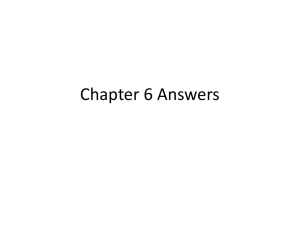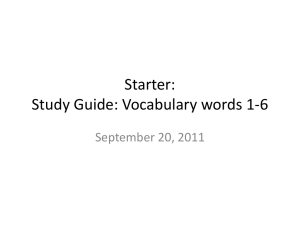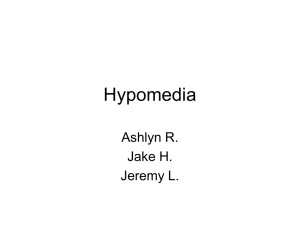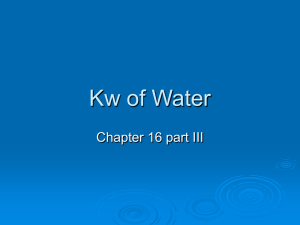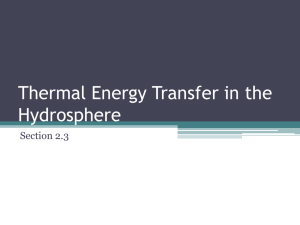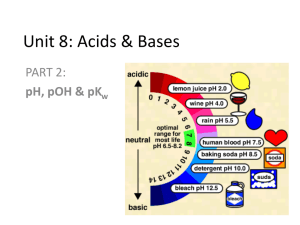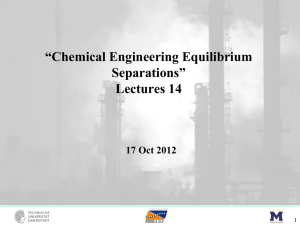Acid-base titrations
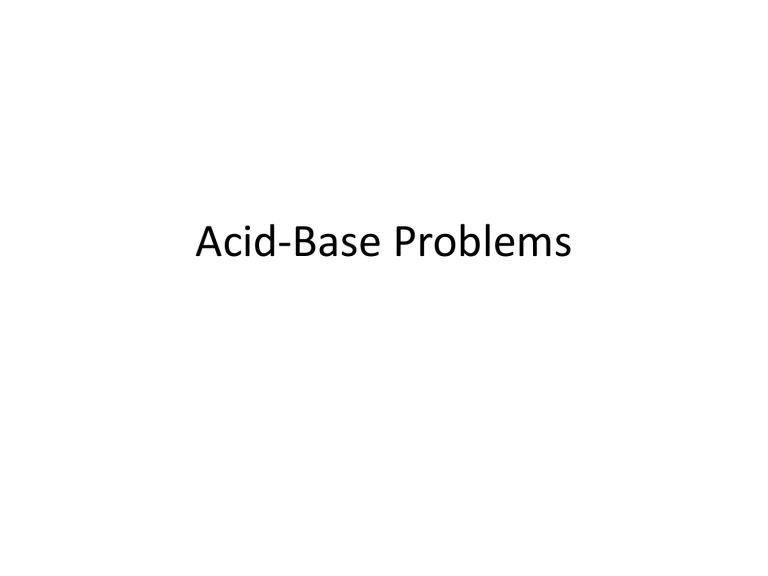
Acid-Base Problems
A complete forward reaction or equilibrium?
• If the problem involves only strong acids and/or bases, the reaction goes to completion
(→).
• If the problem involves a weak acid or base, the reaction involves equilibrium (↔).
If the problem involves only strong acids and/or bases, the reaction goes to completion (→).
• If only strong acid or base, use one of these four relationships to solve:
– pH = -log [H + ] pOH = -log[OH ]
– [H + ][OH ] = K w pH + pOH = 14
• For titration (acid + base), use regular stoichiometry to find molarity, then use log formula to find pH if needed. (or use pH to find molarity depending on given.)
If the problem involves a weak acid or base, the reaction involves equilibrium (↔).
• Use RICE table.
– Weak acids hydrolyze to produce H + and a conjugate base. K is used. a
– Weak bases hydrolyze to produce OH and a conjugate acid. K b is used.
• For titration (acid + base), two steps are needed:
1. Use regular stoichiometry to find which species are left after neutralization.
2. Use RICE table and ionization constant (K a solve with remaining species.
or K
– Note that K a is needed if H + is a product in the equilibirium and K b is needed if OH is a product.
b
) to
To do all titration problems:
I. Start with stoichiometry:
• Write balanced equation for reaction.
• Find # moles H + (or OH ) you are starting with.
• If amount of titrant is given, find how many moles of that you used.
• Use stoichiometry to figure out what is left over. (If you have more H + than OH , then all OH will be converted to water.)
• Subtract the # moles used from the dominant species.
The # moles water will also result in the “liberation” of the same # moles of the conjugate.
II. Analyze what is left after neutralization. If only base is left, use K b and write the ICE table as basic. If only acid is left, use K a table as hydrolysis of the H + .
and write ICE
III. Do equilibrium problem. (ICE table) Do not forget to include the starting concentration of the conjugate (A if you started with HA).
Special case
½ way to equivalence point, pH = pK a cut!)
(This is a short
• At equivalence point, all of the H + is neutralized.
• Note: HA + H
2
O this shortened form:
H
3
O + + A I will write it in
• HA H + + A -
A 27.1 mL sample of a 0.412 M aqueous hydrocyanic acid solution is titrated with a 0.444 M aqueous barium hydroxide solution. What is the pH at the start of the titration, before any barium hydroxide has been added?
Nothing has been added, so it is not a titration yet.
Solve like any equilibrium problem:
HCN H + + CN -
.412 M
-x
0 0 K a
+x +x
= x 2 = 6.2 x 10 -10
.412
.412-x x x x = [H + ] = 1.598 x 10 -5 M pH = -log[H + ] = 4.80
A 41.9 mL sample of a 0.475 M aqueous hydrocyanic acid solution is titrated with a 0.422 M aqueous barium hydroxide solution. What is the pH after 10.0 mL of base have been added?
Stoichiometry:
2HCN + Ba(OH)
2
Ba(CN)
2
2H
2
O + Ba(CN) is water soluble.
2
(.0419 L)(.475 mol/L HCN) = .0199 mol HCN (so .0199 mol H + is available)
(.010L)(.422 mol Ba(OH)
2
)(2mol OH ) = .00844 mol OH -
L L
More H + than OH :
.
0199 mol H + - .00844 mol OH = .01146 mol HCN left
(& .00844 mol CN liberated)
Analyze what is left:
Total volume = .0419 L + .010 L = .0519 LH
2
O, HCN and CN are present
Concentrations:
H
2
O = N/A [HCN] = .01146mol = .221 M [CN
.0519 L
] = .00844 mol = .163 M
.0519 L
Since acid conc is higher, use K a
.
Equilibrium:
HCN H + + CN -
.221 M
-x
.221-x
0 .163
+x +x x .163 + x
K a
= x(.163) = 6.2 x 10
.221
x = [H + ] = 8.4 x 10 -10 pH = -log[H + ] = 9.08
M
-10
When a 29.5 mL sample of a 0.497 M aqueous hydrofluoric acid solution is titrated with a 0.334 M aqueous potassium hydroxide solution, what is the pH at the midpoint in the titration?
• At midpoint, pH = pK a
, so pH = -log (7.2 x 10 -4 ) = 3.14
• You could prove this by finding that it would take .0439 mol OH added to reach equivalence, divide by 2 to get 21.945 mL added at midpoint. Then do ICE to get [H + ] =
7.2 x 10 -4 M.
What is the pH at the equivalence point in the titration of a 19.0 mL sample of a 0.353 M aqueous hydrocyanic acid solution with a 0.408 M aqueous potassium hydroxide solution?
Stoichiometry:
2HCN + Ba(OH)
2
Ba(CN)
2
2H
2
O + Ba(CN) is water soluble.
2
(.010 L)(.353 mol/L HCN) = .00671 mol H + all neutralized by KOH, so:
.00671 mol OH | 1 L = .0164 L KOH used at equivalence
|.408 mol KOH
Total vol =.0164 + .019 =.0354L
Equivalence point:
.00671 mol H + + .00671 mol OH = 0 mol HCN left
(& .00671 mol CN liberated)
Analyze what is left:
Total volume = =.0164L + .019L =.0354L H
2
Oand CN are present
Concentrations:
H
2
O = N/A [CN ] = .00671 mol = .190 M CN -
.0354 L
Since only a conjugate base is present, use K b
: K b
= 1 x 10 -14
6.2 x 10 -10
= 1.61 x 10 -5
Equilibrium:
CN -
.190 M
-x
.190-x
+ H
2
O HCN + OH -
0 0
+x +x x x
K b
= x 2 = 1.61 x 10
.190
x = [OH ] = 8.5 x 10 -5
-5 pOH = -log[OH ] = 4.07
pH = 14 – pOH = 9.93
M
When a 19.4 mL sample of a 0.382 M aqueous hydrocyanic acid solution is titrated with a 0.413 M aqueous barium hydroxide solution, what is the pH after 13.5 mL of barium hydroxide have been added?
Stoichiometry:
2HCN + Ba(OH)
2
Ba(CN)
2
2H
2
O + Ba(CN) is water soluble.
2
.0194L (.382 mol/L HCN) = .0074 mol H +
.0135L|.413 mol Ba(OH)
2
| 2 mol OH -
| L |1 mol Ba(OH)
2
= .01115 mol OH
There are more OH ions, so the solution is basic:
-
01115 moles OH around.
- .0074 mol H + = .00375 mol OH left and .0074 mol CN hanging
More OH than H + :
.00375 mol OH left and .0074 mol CN liberated)
Analyze what is left:
Total volume = =.0194L + .0135L =.0329 L OH , H
2
[OH ] = .00375 mol/ .0329 L = .114 M OH -
O and CN are present
Concentrations:
H
2
O = N/A [OH -
[CN -
] = .00375 mol/ .0329 L = .114 M OH
] = .0074 mol = .225 M CN -
-
.0329 L
BUT…CN is a weak base, and the hydroxide ions it will generate in water will be very few relative to the amount from the strong base used in titration.
Relative to the OH , the CN is negligible, so pOH = -log [OH ] = .94
pH = 14 - .94 = 13.06

